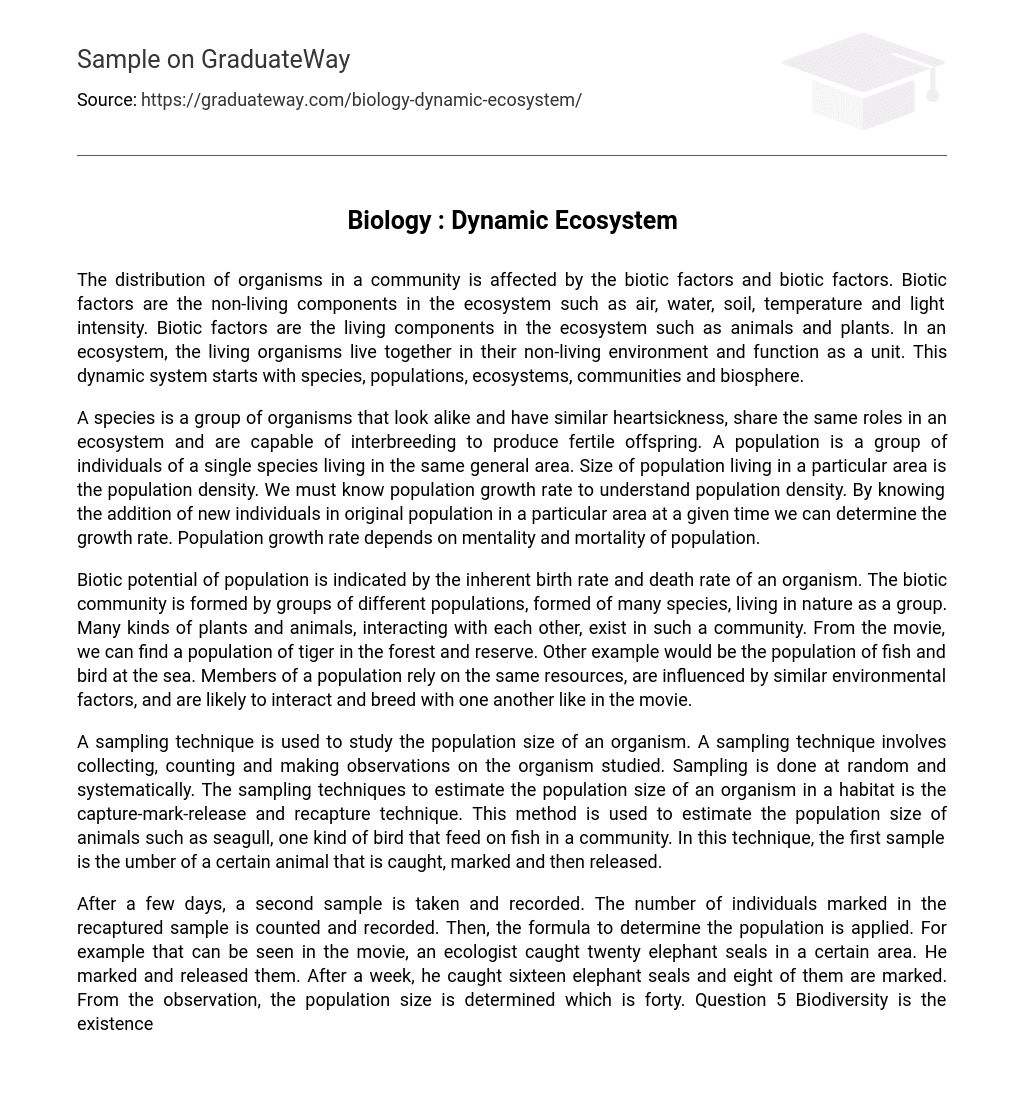The distribution of organisms in a community is affected by the biotic factors and biotic factors. Biotic factors are the non-living components in the ecosystem such as air, water, soil, temperature and light intensity. Biotic factors are the living components in the ecosystem such as animals and plants. In an ecosystem, the living organisms live together in their non-living environment and function as a unit. This dynamic system starts with species, populations, ecosystems, communities and biosphere.
A species is a group of organisms that look alike and have similar heartsickness, share the same roles in an ecosystem and are capable of interbreeding to produce fertile offspring. A population is a group of individuals of a single species living in the same general area. Size of population living in a particular area is the population density. We must know population growth rate to understand population density. By knowing the addition of new individuals in original population in a particular area at a given time we can determine the growth rate. Population growth rate depends on mentality and mortality of population.
Biotic potential of population is indicated by the inherent birth rate and death rate of an organism. The biotic community is formed by groups of different populations, formed of many species, living in nature as a group. Many kinds of plants and animals, interacting with each other, exist in such a community. From the movie, we can find a population of tiger in the forest and reserve. Other example would be the population of fish and bird at the sea. Members of a population rely on the same resources, are influenced by similar environmental factors, and are likely to interact and breed with one another like in the movie.
A sampling technique is used to study the population size of an organism. A sampling technique involves collecting, counting and making observations on the organism studied. Sampling is done at random and systematically. The sampling techniques to estimate the population size of an organism in a habitat is the capture-mark-release and recapture technique. This method is used to estimate the population size of animals such as seagull, one kind of bird that feed on fish in a community. In this technique, the first sample is the umber of a certain animal that is caught, marked and then released.
After a few days, a second sample is taken and recorded. The number of individuals marked in the recaptured sample is counted and recorded. Then, the formula to determine the population is applied. For example that can be seen in the movie, an ecologist caught twenty elephant seals in a certain area. He marked and released them. After a week, he caught sixteen elephant seals and eight of them are marked. From the observation, the population size is determined which is forty. Question 5 Biodiversity is the existence of a wide range of different types of organisms in a given place at a given time.
The diversity of plant and animal life in a particular habitat made up a high level of biodiversity. Our biodiversity is being threatened at an unprecedented scale by global environmental change from human activities. There are many moral reasons to preserve biodiversity since it provides numerous ecosystem services that are crucial to human well-being at past, present and in the future. Ecosystem services are benefits provided by ecosystems to humans, which nutrient to make human life continue and worth. Biodiversity can affect ecosystem services directly.
For example, human feed on animals and plants. Colorful flowers and grass covered the Earth’s surface that can provide enjoyment and nice view. Biodiversity also can affect the provision of ecosystem services indirectly, through its influence on ecosystem processes that are essential to Earth’s life support systems. First and foremost, in order to maintain a balance ecosystem and maintain our biodiversity, we must stop pollution. Pollution gives a very great effect to not only vying organisms but non-living things also.
The types of pollution like air pollution, water pollution and thermal pollution have distracted lives on the Earth. For example, human today are facing breathing difficulties due to the dust and dirty air. Water as a basic need for human is very important to be conserved from being polluted. Not just that, water also plays its role as a habitat for aquatic life. That is why government should take action to conserve water for living needs and in maintaining the ecosystem. Our quality of air is getting worse proved by API (Air Pollution Index), and he result shown was increases day by day.
Next, our government should enforce stricter rules in preserving and conserving wildlife. Conservation of flora and fauna is key to maintain the ecosystems, and there are cultural, ethical, aesthetic and economic reasons to conserve species. Proper punishment should be given to the illegal loggers and illegal poachers to prevent them from continuously destroying our unique flora and fauna. By maintaining healthy and conducive environment, our flora and fauna can continue to flourish and he future generations would have opportunity to meet them.
It is also important to have a good planning of the city layout to save trees, land and forest for animal habitat. We need to have cities but we must keep our Earth green to maintain our natural environment. The building of factories that cause pollution should be limited to keep a healthy environment. The MONGO (non- government organization) can also play their role cooperating with the government to launch public awareness campaign. By doing this, hopefully can make the pupils become more aware of the environmental issue.





